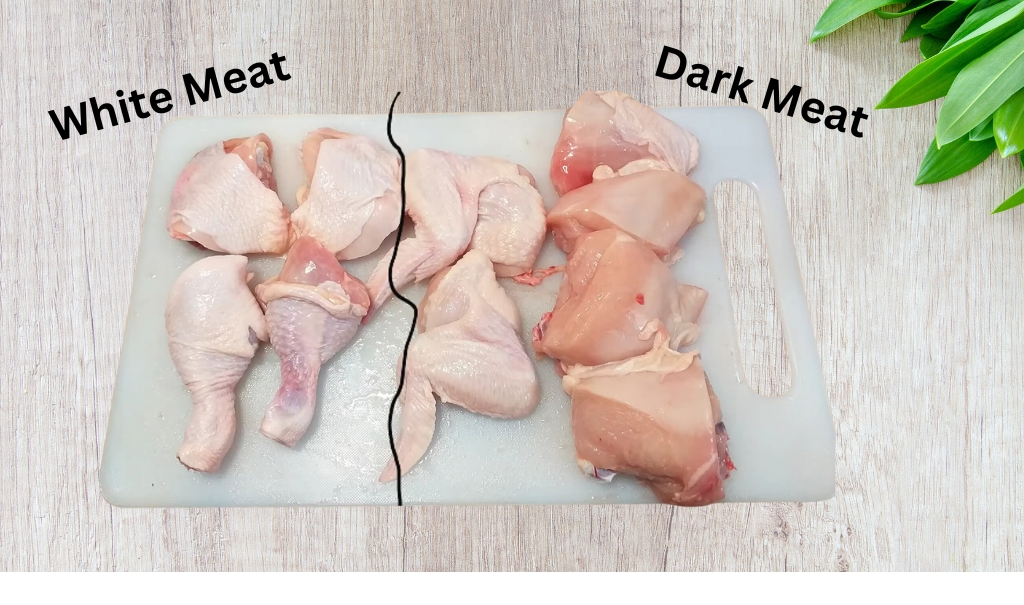You may have heard the argument about dark meat and white meat when it comes to chicken or turkey. But what’s the real difference between them? These differences can help you make smart decisions about what to eat, whether you’re cooking at home, going out to eat, or just interested in what you’re eating. Here are five main ways that dark meat and white meat are different.

The difference between Dark Meat And White Meat
Here is the difference between dark meat and white meat:
What is Dark Meat?
The drumsticks of chicken and turkey, as well as the legs and thighs, have dark meat. People say that these parts taste better and are richer. Dark meat has a darker colour and a juicier taste because it has more fat and myoglobin, a protein that helps muscle cells store oxygen.
What is White Meat?
The breast and wings of the bird are where the white meat comes from. It’s leaner and has less fat, so many people choose to cut back on calories. White meat is lighter in colour and tastes less strong than meat that is dark. It also has a firmer taste and can be a little drier, especially if it’s cooked too long.
Differences in the nutrition of Dark Meat And White Meat
Comparison of Calorie Content
In comparison, dark and white meat usually have more calories than white meat. One 3-ounce serving of roasted chicken thigh has about 210 calories, while one 3-ounce serving of roasted chicken breast has about 170 calories. Even though the difference may not seem like much, it can add up, especially if you’re trying to watch how many calories you eat.
Types and amounts of fat
The amount of fat is the most important difference between dark meat and white meat. Dark meat has a deeper flavour and a more juicy texture because it contains more saturated fat. There are about 9 grams of fat in 3 ounces of chicken thighs but only 3.5 grams in 3 ounces of chicken breasts. But not every fat is bad. There are also more healthy polyunsaturated fats in dark meat, which can be good for your heart.
How Much Protein Is in Dark Meat and White Meat?
Both dark and white meat are good sources of protein, but white meat has a little more than dark meat. About 26 grams of protein are in a 3-ounce amount of chicken breast, while only 19 grams are in the same-sized serving of chicken thighs. If you want to eat more protein, white meat is the best choice.
Differences in Taste and Texture of Dark Meat And White Meat
Because it has more fat, dark meat tastes stronger and fuller, and people often describe it as “gamey.” White meat, on the other hand, is softer and more delicate. This makes it a flexible choice that can be seasoned and flavoured in many ways.
Differences in Feel
Dark meat is known for being soft and juicy, and it stays moist even after being cooked for a long time. If you don’t cook it right, white meat can get dry and tough because it is leaner. Because of this change in texture, dark meat is better for people who aren’t sure they can cook well.
How Cooking Methods Affect Flavor
The way you cook both dark and white meat can have a big effect on its taste and appearance. If you roast, grill, or fry dark meat, it will taste even better. If you bake or poach white meat, it will stay soft and juicy.
Effects on Health of Dark Meat And White Meat
Here are the health effects of dark meat and white meat:
Pros and Cons of Dark Meat
The fact that dark meat has more fat can be good and bad. On the one hand, fats can help people on a ketogenic or low-carb diet. However, people worried about their hearts might not want to eat this because it has more fatty fat. But it’s important to remember that dark meat has nutrients like zinc and iron.
Pros and Cons of White Meat
People who want to reduce fat and keep their diet lean are often told to eat white meat. A lot of people who are trying to lose weight love it because it has fewer calories. But because it has less fat, it can be less tasty and more likely to dry out if it’s not cooked right.
What it Does to Heart Health
Because it has less fatty fat, white meat is usually thought to be better for those with heart health. However, the monounsaturated fats in dark meat can also be good for your heart if you eat them in moderation.
Cooking and Culinary Uses
Best Cooking Methods for Dark Meat
When cooked slowly, like in braising, stewing, and baking, dark meat tastes great. In these ways, the meat stays moist and tender while getting lots of flavor. People also like to grill and fry, which makes the meat crispy on the outside while keeping it juicy on the inside.
Best Cooking Methods for White Meat
It’s best to cook white meat quickly so it doesn’t dry out. Great ways to cook them are by grilling, baking, or boiling. If you marinate the meat ahead of time, it will stay moist and taste even better.
Conclusion
Dark meat and White meat are both healthy, but they taste and are made in different ways. Dark meat is rich, juicy, and full of flavour, but white meat is lighter and can be used in more ways. In the end, the choice between the two depends on personal taste, food needs, and how creatively you want to cook. That said, whether you like dark meat or white meat, you can eat both as part of a healthy, tasty diet.
FAQs
Is dark meat always healthier than white meat?
Not necessarily. It depends on your dietary needs and preferences. Dark meat has more fat and calories, but it also contains more nutrients like iron and zinc.
Does white meat dry out more easily than dark meat?
Yes, white meat can dry out more easily because it has less fat. Proper cooking methods, like marinating and not overcooking, can help keep it moist.
Can I substitute dark meat for white meat in recipes?
Absolutely! Remember that dark meat has a richer flavour and can change the dish’s overall taste and texture.
Is one type of meat better for weight loss?
White meat is typically better for weight loss because it has fewer calories and less fat. However, portion control and overall diet matter more than the type of meat.
What’s the best way to cook dark meat to keep it healthy?
Grilling, baking, or roasting without added fats are good ways to keep dark meat healthy. Removing the skin can also reduce fat content.


